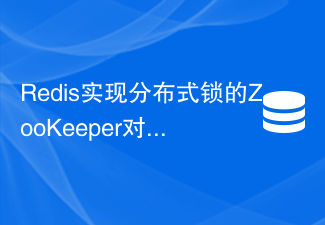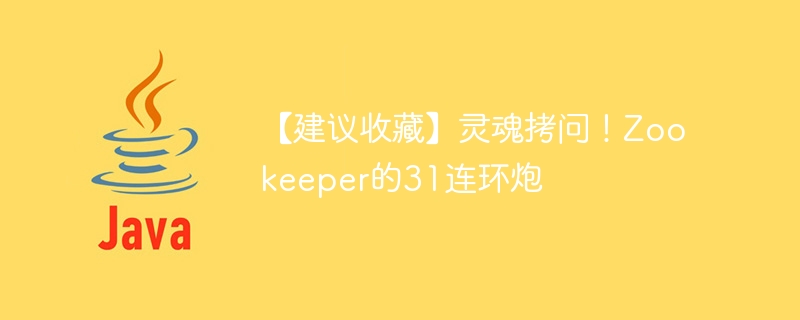ZooKeeper is a distributed, open source distributed application coordination service. It is an open source implementation of Google's Chubby and an important component of Hadoop and Hbase. This article will share with you the simple use of zookeeper in java. Friends who need it can refer to it
1. The basic principles of zookeeper
data model , as follows:

The structure of the ZooKeeper data model is very similar to the Unix file system. It can be regarded as a tree as a whole, and each node is called Make a ZNode. Each ZNode can be uniquely identified by its path. For example, the first ZNode in the third layer in the above figure has a path of /app1/c1. A small amount of data can be stored on each ZNode (the default is 1M, which can be modified through configuration. It is generally not recommended to store large amounts of data on ZNode). This feature is very useful. In addition, each ZNode also stores its Acl information. It should be noted here that although the tree structure of ZNode is very similar to the Unix file system, its Acl is completely different from the Unix file system. The Acl of each ZNode is independent. , the child node will not inherit the parent node.
ZooKeeper features:
##1. Read and write (update) mode
2, WAL and Snapshot
3. FIFO
4. Linearizability
2. Common commands of zookeeper
We can execute zookeeper-client or /opt/cloudera/parcels/CDH-5.0.0 -1.cdh5.0.0.p0.47/lib/zookeeper/bin/zkCli.sh-server localhost, enter the zookeeper command line, as follows:




3. Zookeeper’s javaapi operation
Regarding the Javaapi operation of zookeeper, it is relatively simple. The author directly posted the code, as follows:packageorg.zookeeper.demo;
importjava.io.IOException;
importjava.util.concurrent.CountDownLatch;
importorg.apache.zookeeper.CreateMode;
importorg.apache.zookeeper.KeeperException;
importorg.apache.zookeeper.WatchedEvent;
importorg.apache.zookeeper.Watcher;
importorg.apache.zookeeper.Watcher.Event.KeeperState;
importorg.apache.zookeeper.ZooDefs.Ids;
importorg.apache.zookeeper.ZooKeeper;
publicclassZookeeperClientimplementsWatcher{
//连接超时时间,10s
privatestaticfinalintSESSION_TIMEOUT= 10000;
//连接的zookeeperserver
privatestaticfinalStringCONNECTION_STRING = "172.31.25.8:2181";
privatestaticfinalStringZK_PATH = "/qyktest";
privateZooKeeperzk = null;
privateCountDownLatchconnectedSemaphore = newCountDownLatch(1);
publicvoidcreateConnection(StringconnectString, intsessionTimeout){
this.releaseConnection();
try{
zk= newZooKeeper(connectString,sessionTimeout, this);
connectedSemaphore.await();
}catch(InterruptedExceptione) {
System.out.println("连接创建失败,发生InterruptedException");
e.printStackTrace();
}catch(IOExceptione) {
System.out.println("连接创建失败,发生IOException");
e.printStackTrace();
}
}
publicvoidreleaseConnection(){
if(this.zk!= null){
try{
this.zk.close();
}catch(InterruptedExceptione) {
e.printStackTrace();
}
}
}
publicbooleancreatePath(Stringpath, String data) {
try{
Stringresult = this.zk.create(path,data.getBytes(), Ids.OPEN_ACL_UNSAFE,CreateMode.PERSISTENT);
System.out.println("节点创建成功,Path: "+result + ", content: "+data);
}catch(KeeperExceptione) {
System.out.println("节点创建失败,发生KeeperException");
e.printStackTrace();
}catch(InterruptedExceptione) {
System.out.println("节点创建失败,发生InterruptedException");
e.printStackTrace();
}
returntrue;
}
publicStringreadData(Stringpath) {
try{
System.out.println("获取数据成功,path:"+path);
returnnewString(this.zk.getData(path,false,null));
}catch(KeeperExceptione) {
System.out.println("读取数据失败,发生KeeperException,path:"+path);
e.printStackTrace();
return"";
}catch(InterruptedExceptione) {
System.out.println("读取数据失败,发生InterruptedException,path: "+path);
e.printStackTrace();
return"";
}
}
publicbooleanwriteData(Stringpath, String data) {
try{
System.out.println("更新数据成功,path:"+path + ", stat: "+this.zk.setData(path,data.getBytes(), -1));
}catch(KeeperExceptione) {
System.out.println("更新数据失败,发生KeeperException,path:"+path);
e.printStackTrace();
}catch(InterruptedExceptione) {
System.out.println("更新数据失败,发生InterruptedException,path: "+path);
e.printStackTrace();
}
returnfalse;
}
publicvoiddeleteNode(Stringpath) {
try{
this.zk.delete(path,-1);
System.out.println("删除节点成功,path:"+path);
}catch(KeeperExceptione) {
System.out.println("删除节点失败,发生KeeperException,path:"+path);
e.printStackTrace();
}catch(InterruptedExceptione) {
System.out.println("删除节点失败,发生InterruptedException,path: "+path);
e.printStackTrace();
}
}
publicstaticvoidmain(String[]args) {
ZookeeperClientsample = newZookeeperClient();
//获取连接
sample.createConnection(CONNECTION_STRING,SESSION_TIMEOUT);
//读数据
Stringqyk = sample.readData("/qyktest");
System.out.println("qyk:"+qyk);
Stringurl = sample.readData("/qyk/db/url");
System.out.println("url"+url);
Stringdriver = sample.readData("/qyk/db/driver");
System.out.println("driver"+driver);
StringuserName = sample.readData("/qyk/db/userName");
System.out.println("userName"+userName);
Stringpassword = sample.readData("/qyk/db/password");
System.out.println("password"+password);
//创建节点
sample.createPath(ZK_PATH,"我是节点初始内容");
System.out.println("数据内容:"+sample.readData(ZK_PATH) + "\n");
//更新节点
sample.writeData(ZK_PATH,"更新后的数据");
System.out.println("数据内容:"+sample.readData(ZK_PATH) + "\n");
//删除节点
sample.deleteNode(ZK_PATH);
//释放连接
sample.releaseConnection();
}
@Override
publicvoidprocess(WatchedEventevent) {
System.out.println("收到事件通知:"+event.getState() + "\n");
if(KeeperState.SyncConnected== event.getState()) {
connectedSemaphore.countDown();
}
}
}Then, when executed, you can see that the console output is as follows:

So, like some We can save the public configuration in zookeeper, and then other services can use it
Summary
The above is the detailed content of Detailed explanation of the use of zookeeper in java. For more information, please follow other related articles on the PHP Chinese website!
 Java API 开发中使用 ZooKeeper 进行分布式锁处理Jun 17, 2023 pm 10:36 PM
Java API 开发中使用 ZooKeeper 进行分布式锁处理Jun 17, 2023 pm 10:36 PM随着现代应用程序的不断发展和对高可用性和并发性的需求日益增长,分布式系统架构变得越来越普遍。在分布式系统中,多个进程或节点同时运行并共同完成任务,进程之间的同步变得尤为重要。由于分布式环境下许多节点可以同时访问共享资源,因此,在分布式系统中,如何处理并发和同步问题成为了一项重要的任务。在此方面,ZooKeeper已经成为了一个非常流行的解决方案。ZooKee
 带你搞懂Java结构化数据处理开源库SPLMay 24, 2022 pm 01:34 PM
带你搞懂Java结构化数据处理开源库SPLMay 24, 2022 pm 01:34 PM本篇文章给大家带来了关于java的相关知识,其中主要介绍了关于结构化数据处理开源库SPL的相关问题,下面就一起来看一下java下理想的结构化数据处理类库,希望对大家有帮助。
 在Beego中使用ZooKeeper和Curator进行分布式协调和管理Jun 22, 2023 pm 09:27 PM
在Beego中使用ZooKeeper和Curator进行分布式协调和管理Jun 22, 2023 pm 09:27 PM随着互联网的迅速发展,分布式系统已经成为了许多企业和组织中的基础设施之一。而要让一个分布式系统能够正常运行,就需要对其进行协调和管理。在这方面,ZooKeeper和Curator是两个非常值得使用的工具。ZooKeeper是一个非常流行的分布式协调服务,它可以帮助我们在一个集群中协调各个节点之间的状态和数据。Curator则是一个对ZooKeeper进行封装
 一起聊聊Java多线程之线程安全问题Apr 21, 2022 pm 06:17 PM
一起聊聊Java多线程之线程安全问题Apr 21, 2022 pm 06:17 PM本篇文章给大家带来了关于java的相关知识,其中主要介绍了关于多线程的相关问题,包括了线程安装、线程加锁与线程不安全的原因、线程安全的标准类等等内容,希望对大家有帮助。
 php如何使用PHP的Zookeeper扩展?Jun 02, 2023 pm 09:01 PM
php如何使用PHP的Zookeeper扩展?Jun 02, 2023 pm 09:01 PMPHP是一种非常流行的编程语言,广泛应用于Web应用程序和服务器端开发。Zookeeper是一个分布式的协调服务,用于管理、协调和监控分布式应用程序和服务。在PHP应用程序中使用Zookeeper可以提高应用程序的性能和可靠性。本文将介绍如何使用PHP的Zookeeper扩展。一、安装Zookeeper扩展使用Zookeeper扩展需要安装Zookeeper
 Redis实现分布式锁的ZooKeeper对比Jun 20, 2023 pm 03:19 PM
Redis实现分布式锁的ZooKeeper对比Jun 20, 2023 pm 03:19 PM随着互联网技术的迅速发展,分布式系统在现代应用中已经得到广泛应用,特别是在大型互联网企业中更是必不可少。但是在分布式系统中,各个节点之间要保持一致性是非常困难的,因此分布式锁机制成为了解决这个问题的基础之一。在分布式锁的实现中,Redis和ZooKeeper都是比较流行的工具,本文将对它们进行一些对比和分析。Redis实现分布式锁Redis是开源的内存数据存
 分布式锁用 Redis 还是 Zookeeper?Aug 22, 2023 pm 03:48 PM
分布式锁用 Redis 还是 Zookeeper?Aug 22, 2023 pm 03:48 PM分布式锁的实现方式通常有:数据库、缓存(比如:Redis)、Zookeeper、etcd,实际开发中,使用的最多还是Redis和Zookeeper,所以,本文就只聊这两种。
 【建议收藏】灵魂拷问!Zookeeper的31连环炮Aug 28, 2023 pm 04:45 PM
【建议收藏】灵魂拷问!Zookeeper的31连环炮Aug 28, 2023 pm 04:45 PMZooKeeper 是一个开源的分布式协调服务。它是一个为分布式应用提供一致性服务的软件,分布式应用程序可以基于 Zookeeper 实现诸如数据发布/订阅、负载均衡、命名服务、分布式协调/通知、集群管理、Master 选举、分布式锁和分布式队列等功能。


Hot AI Tools

Undresser.AI Undress
AI-powered app for creating realistic nude photos

AI Clothes Remover
Online AI tool for removing clothes from photos.

Undress AI Tool
Undress images for free

Clothoff.io
AI clothes remover

AI Hentai Generator
Generate AI Hentai for free.

Hot Article

Hot Tools

Dreamweaver Mac version
Visual web development tools

VSCode Windows 64-bit Download
A free and powerful IDE editor launched by Microsoft

MinGW - Minimalist GNU for Windows
This project is in the process of being migrated to osdn.net/projects/mingw, you can continue to follow us there. MinGW: A native Windows port of the GNU Compiler Collection (GCC), freely distributable import libraries and header files for building native Windows applications; includes extensions to the MSVC runtime to support C99 functionality. All MinGW software can run on 64-bit Windows platforms.

PhpStorm Mac version
The latest (2018.2.1) professional PHP integrated development tool

SAP NetWeaver Server Adapter for Eclipse
Integrate Eclipse with SAP NetWeaver application server.






